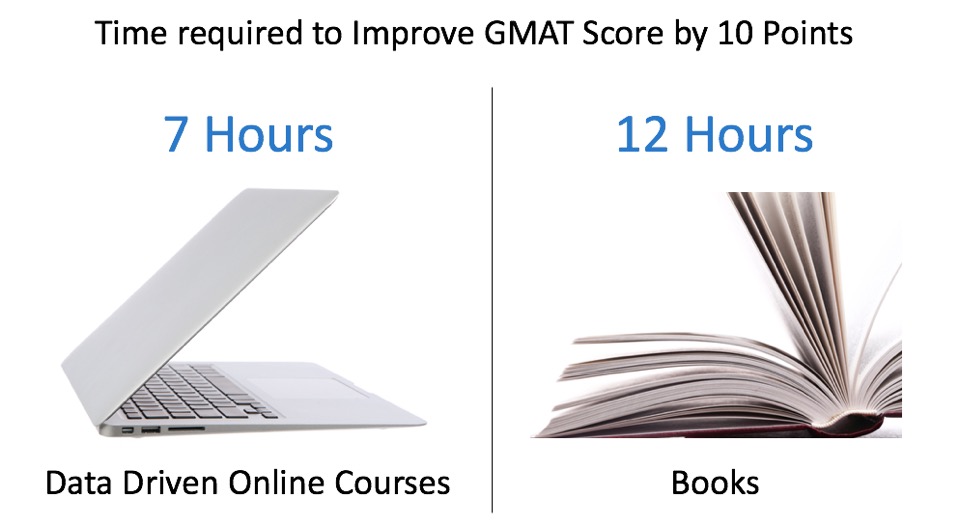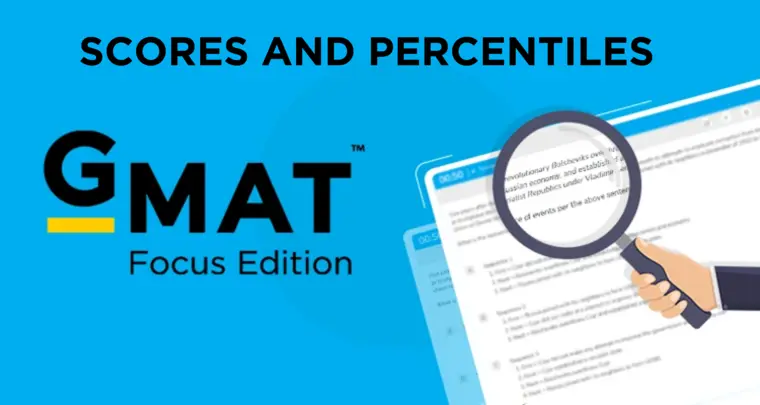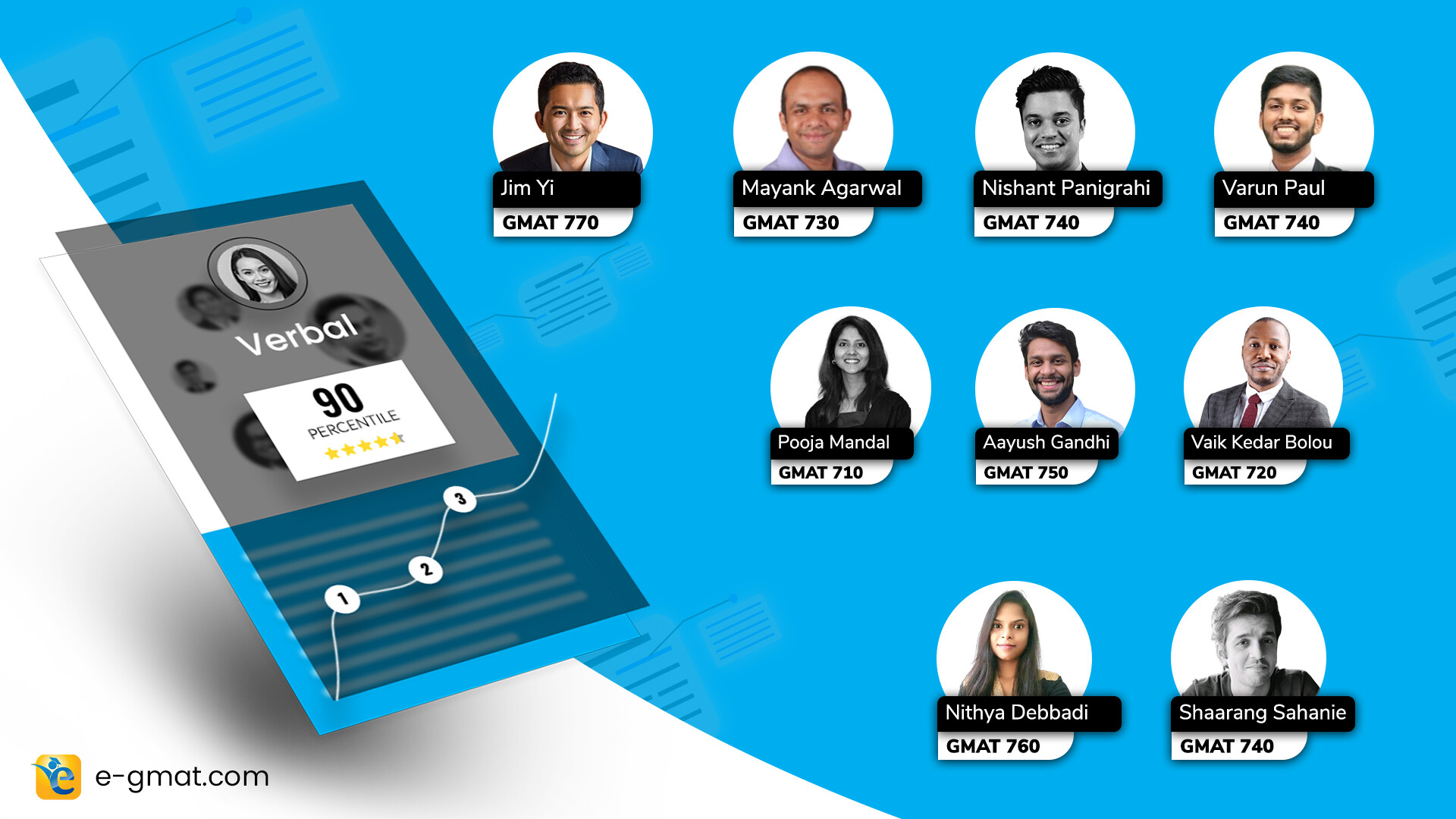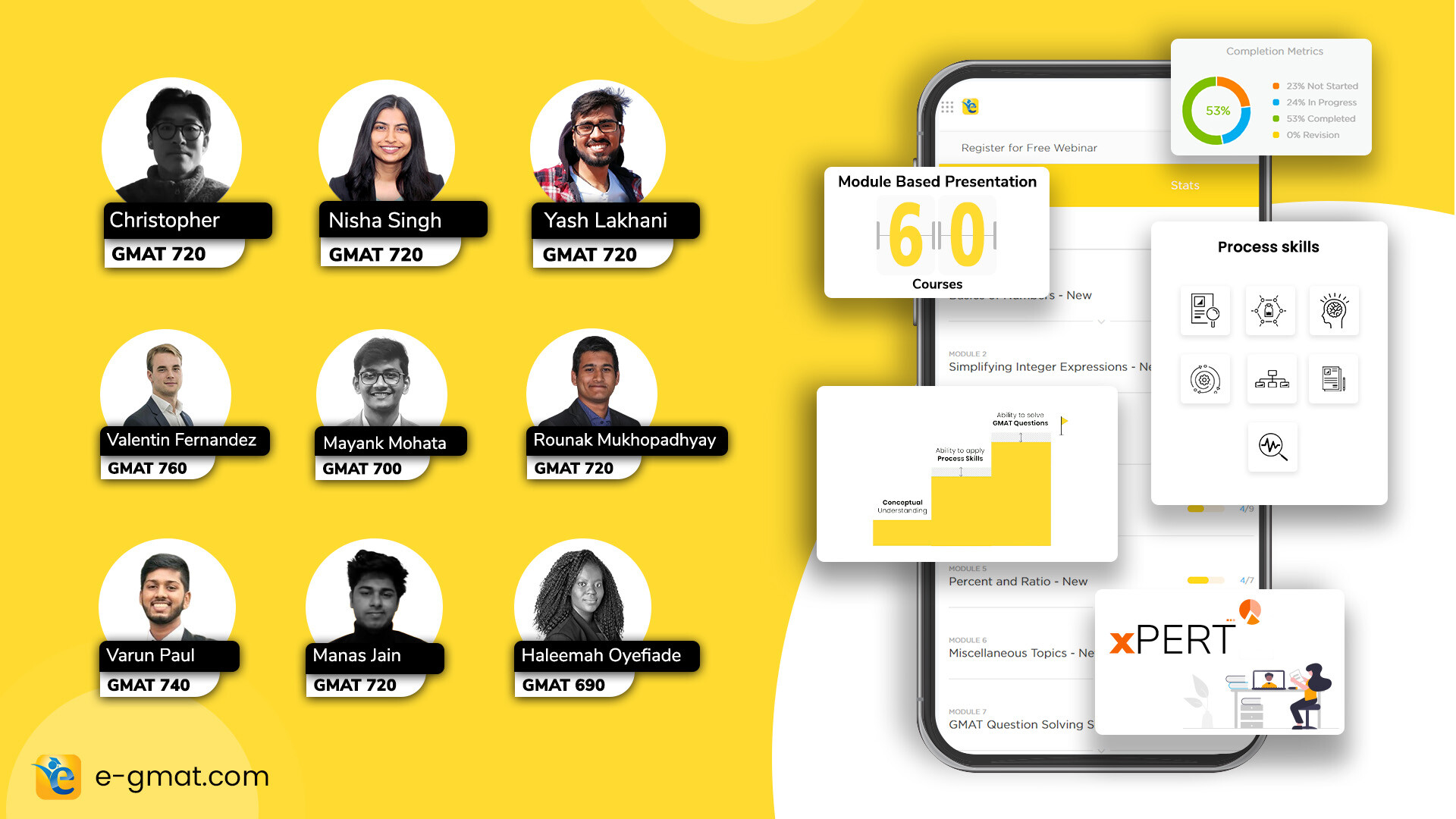Of the many emails that we receive every day, the most common question we get asked is one or the other version of “Give me a study plan to achieve 700+ GMAT score”. Another version of the same question is – how can I reach a score of 700 on the GMAT? At e-GMAT, we do not believe in general/standard plans for everyone. Why? Because every student possesses a different skill set and hence requires a customized path to get to their target score. Therefore, to cater to these (specific) needs, we need personalized study plans (rather than a generic one).
Watch this video where we highlight how can a personalized GMAT study plan can help you save 60+ hours of GMAT preparation time:

In this post, we have included GMAT Study Plan for 3 case scenarios – 150 points score improvement, 200 points score improvement and 250 points score improvement.
We have covered the following aspects:
- Benefits of a Personalized GMAT Study Plan
- How to create a personalized GMAT study plan?
- GMAT Study Plan for 250 Points Score Improvement – 400 to 650
- Personalized Study Plan for 200 Points Score Improvement – 500 to 700
- How to score GMAT 750 – Personalised GMAT Study Plan (Starting Score 600)
1. BENEFITS OF A PERSONALISED GMAT STUDY PLAN
Creating a personalized study plan takes a few hours of effort. So, you may be wondering – why should you spend all this time preparing a study plan when you already have a lot to study. Read below to understand some potential benefits of creating your personalized study plan:
1.1 SAVE 40+ HOURS OR SCORE 50 POINTS HIGHER

With a personalized study plan, you can reduce your study time by 30% to achieve the same score. If you have a lot of time and insist on using it entirely for GMAT prep, then it can help you add 50 points to the score you would have achieved if you followed a general plan or no plan at all. Here’s an example of such stellar performance – Read about Rhea’s Success Story and watch her interview to understand how a Proper GMAT Study Plan helped her reduce the preparation time and improve her score from 620 to 760 in just 40 days!
1.2 IMPROVE YOUR CHANCES OF ADMISSIONS TO TOP COLLEGES

An optimized study plan also increases your chance of reaching your target score, which could be the difference between getting an admit or being waitlisted, or being out of the race for your dream college. Here is Prawee’s story – She learned from her mistakes and analyzed every mistake to improve to 740 (from 550) in her final attempt and got Scholarships from 3 top schools amounting to $180,000 cumulatively. Prawee finally joined Kellogg.
A personalized study plan will be of immense help if you are retaking the GMAT. Learn a 5-step strategy to ace the GMAT in your reattempt.
To help you effectively plan for the GMAT we have created an amazing tool called the Personalized Study Planner (PSP) tool. Create your own milestone-driven GMAT study plan in 5 minutes.
Here are the features of this GMAT study plan tool and here is the link to the PSP tool itself.
We can help you with a personalized study plan and give you access to quality online content to prepare. Write to us at acethegmat@e-gmat.com. We are the most reviewed GMAT prep company on gmatClub with more than 2000 reviews. Why don’t you take a free trial and judge for yourself?
1.3 GET A SCHOLARSHIP/FELLOWSHIP
While a 700 may open the doors of quite a few good colleges for you, a 750 will ensure you get scholarships/fellowships from these colleges. (Remember I just mentioned in point 1 that in the same time duration you could add 50 points to your score – the difference between 700 and 750). Not yet convinced? Go through Victor’s Video interview and you’ll understand how he received an admit from Wharton with GMAT 770 when he didn’t even get an admit after scoring 710 in his previous attempt.

For further details on MBA Scholarships and GMAT Scores, refer to our article here.
Now that you’ve seen the benefits of following a personalized study plan, let’s look at the steps to create one
Also, take a look at study plans for working professionals and GMAT study plan for 1 month, and GMAT study plan for 3 months.
2. HOW TO CREATE A PERSONALIZED GMAT STUDY PLAN?
Fundamentally, a study plan is personalized on basis of two things – your starting score and your target score. It is essential that you decide on a target score early on to make your study goal oriented and the most important feature of a goal is that it must be measurable.
Step 1: Decide on your target Quant and Verbal scores
You can score 700 on the GMAT by scoring Q50, and V34. Conversely, you can also score 700 by Scoring Q42 and V44. While a Q50 is 85th percentile on GMAT Quant, a Q42 is mere 43rd percentile (Check this article to know more about GMAT scores and percentiles). Clearly, the study plans for GMAT Quant in both cases will be vastly different. Therefore, it’s important to decide whether your strategy is Quant driven or Verbal driven.
How to decide on your target Quant and Verbal Percentiles?
We have built a tool called GMAT PSP tool to help you decide on your target GMAT Quant Percentile and GMAT Verbal Percentile.
If you are wondering whether this target break-up is the final one, the answer is no. This is just one of the many ways to reach your target score recommended based on your inputs. You can tweak it to suit yourself better. While tweaking, remember the following points:
- If you are strong in Quant – tweak the quant score to Q49+ and let the tool suggest the corresponding Verbal score required to reach your target score.
- Likewise, if you are strong in Verbal – tweak the verbal score to V40+ and let the tool suggest the required Quant score
- If you feel that you are not strong in either – target slightly higher Verbal percentiles than Quant. Why? Well, because it is easier for one to improve in GMAT verbal than it is to improve in Quant for someone who is not already comfortable in Quant.
You can refer to this article to understand the process of setting sectional and sub-sectional target scores better.
Step 2: Estimate the amount of time you need
Once you have a clear understanding of where you are and where you want to be, it is all about the time required and the journey to get there. We will first look at the time required and discuss the journey in the subsequent sections.
If your approach to GMAT preparation is dedicated, consistent, and data-driven you would need approximately 7 hours of study to improve by 10 points (on a scale of 800) in the total score. This is usually the case with Online courses as they are more engaging and provide active feedback. This not only makes it easier for students to concentrate longer and better but also ensures that students require half as many revisions to reach a high level of competence. However, if you are using books to study, you would need approximately 12 hours per 10 points (scale of 800) of improvement.

i. Does this estimate work uniformly across all starting scores and percentiles?
For 90% of the students this score improvement estimate works quite well as long as:
- You study consistently putting in at least 12 hours per week.
- You study using one resource.
- You don’t change your study direction frequently; i.e. don’t follow a strategy to study Sentence Correction for 3 days, and then switch to studying Critical Reasoning or Quant without completing Sentence Correction.
The only exception would be if you are extremely weak in a particular topic. For example, if a student’s starting percentile in Sentence Correction is 25 percentile then the student should put in an additional 25% to this time estimate (for Sentence Correction only). The same holds true if you are truly weak in GMAT Quant. Let’s call this factor Confidence Building Time (CBT). CBT can take a value of 0.0 or 0.25 (more on this later).
ii. TakeAway – it’s not about completing a course but about reaching a level of competence
On the basis of the principle above, a diligent student seeking 100-point improvement should be able to do so by using a data-driven online course in as few as 80 hours. Similarly, a 200-point score improvement would require 160 hours of effort using the same online course. Now, why do you need to spend more time on the same course to attain higher score improvement – because acing the GMAT is not about knowing the content, it is about mastering the application of content.
The extent of score improvement depends on the extent to which you master the application of content. Mastering application requires revising the same course material multiple times, understanding the nuances, and ensuring that you don’t make the same mistakes again like Anupriya (GMAT 760, V46) did.

iii. Putting it all Together – A rule of thumb for time requirement
Putting everything above together, here is a simple formula to estimate the time required:
Time required (in hours) = [Target GMAT Score – Starting GMAT Score] X [ 7/10] X [1+CBT]
Where:
- Target GMAT Score = final score that you desire
- Starting GMAT score = Starting score on an official mock test
- 7/10 = 7 hours of effort for every 10 point score improvement
- CBT = Confidence Building Time factor; its value can be 0.0 or 0.25
Step 3: Decide on a mechanism to track your improvement

Once you have all your scores and you have scheduled enough time for your preparation it is time for you to get studying. While studying you must regularly track your improvement. Note, regularly does not mean “constantly”; rather it means that at well-defined intervals. Some students, anxious by nature, start taking weekly mock tests – a practice that is extremely counter-productive early on during your preparation.
What are you really tracking?
Quite Simply – To what extent have you improved your ability to apply the concept?
Very often students are extremely confident about a particular concept but don’t do as well when that concept is tested on GMAT. The reason is while they understand the concept they lack the ability to apply it, and therefore it is a best practice to keep tracking your understanding at regular intervals.
Tracking alone is not sufficient. You must act on the information that you get from tracking. If you are weak in a particular topic you must go back and revise it. Once you have done so (revised the weak topic) you must again check how much that revision has helped in your ability to solve questions on that concept. You must improve until you reach your target ability level in each sub-section and section.
To execute the plan effectively, you must devise a mechanism to track and get feedback. For e-GMAT students, you need not look any further than feedback that you will get at the end of the application files, practice quizzes, and quizzes in Scholaranium. For those of you who are not e-GMAT students, you may want to make sure that you set up this mechanism through an alternate means.
Now that we have the general principles in place, let us apply these principles to create a few study plans.
Take a look at this article, where we have explained the ideal GMAT timing strategies by leveraging the adaptive nature of GMAT to maximize score.
3. Personalized Study Plan – GMAT 400 to 650
Let’s see how we will craft a study plan to improve from a starting score of 400 (Q20, V23) with an aim to score 650 on the test. We will follow the same three steps as we outlined before.
3.1 Defining Target Quant and Verbal Scores
A score of 400 out of 800 corresponds to 10 percentile, whereas a score of 650 corresponds to 73 percentile. Two things jump out from these data points:
- This student is seeking an extremely high score improvement – 250 points on a scale of 800 or 63 percentile points (73 – 10 = 63).
- This student is likely weak in both Quant and Verbal.
A Verbal Driven Strategy makes more sense here
This student’s starting score is 400 (Q20, V23) – a Q20 is 6 percentile whereas V23 is 32 percentile. While this student is weak in both quant and verbal, it is quite evident that this student’s relative strength is Verbal. Therefore, a Verbal driven strategy makes more sense here i.e. we would aim for higher scores in Verbal than in Quant. Why – because for students weak in Quant, it is easier (comparatively) to improve GMAT Verbal.
The recommended break up for 650 would then be a V38 (85 percentile) and Q42 (43 percentile), implying that this student would need to improve by 52 percentile points in Verbal and 37 percentile points in Quant.
3.2 Estimating the Amount of Time Required
Using the formula described above, the time required to improve from a starting GMAT score of 400 to 650 (250 points) should require the following amount of time:
Baseline time requirement
| Starting GMAT Score | 400 |
| Target GMAT Score | 650 |
| CBT Applicable | Yes, since the student is quite weak in both Quant and Verbal |
| Medium of Learning | Data-driven online course |
Overall Time Required (using online courses) = [650 – 400] X [7/10] X [1+0.25] = 218.75 hours ~ 220 hours
NOTE – The same student would require 375 hours when studying using books.
Allocating Time between Quant and Verbal
These 220 hours used need to be allocated between Quant and Verbal. Considering the target Quant and Verbal scores, this student
will need to invest approx. 115 hours in Verbal and 80 hours in Quant. The remaining 20-25 hours are reserved for mocks.
3.3 Creating a GMAT Study Plan

At this point, this student needs to take a few other decisions:
- Which GMAT section to study first – Verbal or Quant? What should be the sequence of studying GMAT Verbal?
- Where (which sub-sections) to spend time on in Verbal and in Quant?
- How often to track improvement and how?
3.3.1 Studying for GMAT Verbal – Ace every section
This student’s strategy is Verbal driven – which is also evident from the fact that a majority of score improvement is contributed by Verbal. Hence, this student should start with GMAT Verbal. This student should start with Sentence Correction, reach at least 80 percentile ability in Sentence Correction, then move on to Critical Reasoning (reaching 70 percentile ability), and finally study reading comprehension. To learn how we decided the SC/CR/RC percentiles, visit the article – how to score V40 on GMAT verbal.
3.3.2 Studying for Quant – Selective focus
Contrary to GMAT Verbal in which this student aimed for 85 percentile, this student needs only 43 percentile in GMAT Quant. Hence, the student does not need to study every section in GMAT Quant. The 80 hours for Quant should ideally be distributed between three sections – Number Properties, Algebra, and Word Problems, without spending much time on Geometry and Advanced Topics (P&C, Probability, etc.). In fact, studying every section in Quant may be counterproductive as this student may not be able to achieve the level of mastery needed in the required sections.
3.4 Tracking Score Improvement?
As mentioned in section 3.3 – the best way to track improvement is by using ability quizzes. Ability quizzes provide much more accurate ability estimates than mocks do. The best thing is in addition to providing a reliable estimate of your ability, ability quizzes also provide useful insights into the areas to focus on to improve your ability to the next level. Hence, it is not surprising that e-GMAT’s Scholaranium is rated higher than GMAT Prep mock tests on GMAT Club.
P.S. – If you have any queries regarding the study plan, do write to us at acethegmat@e-gmat.com along with the plan that you create for yourself. We will be happy to assist you in acing GMAT!

4. GMAT Study Plan – 500 to 700 – 200 Points Score Improvement
Let’s take the second example – how to improve from a starting score of 500 (Q47, V15) to an impressive 700 (88 percentile). We will follow the same steps as we outlined before.
4.1 Defining Target Quant and Verbal Scores
Let’s now review what the score improvement in this case – from 500 to 700 (27 percentile to 88 percentile) implies:
- This student is seeking a high score improvement – 200 points on a scale of 800 or 61 percentile points (88 – 27 = 61).
- This student is very weak in Verbal but is strong in Quant
A Quant Driven Strategy makes more sense here
- Starting Score = 500 (Q47, V15)
- Starting Percentiles = Quant – 61 percentile, Verbal – 10 percentile
Since in this case, the student’s relative strength is Quant, we recommend a Quant-driven strategy i.e. we would aim for higher scores in Quant than in Verbal.
This means that:
- Final Score = 700 (Q51, V32)
- Final Percentiles = Quant – 96 percentile, Verbal – 66 percentile
Hence, the Score improvement required is 56 percentile points in Verbal and 35 percentile points in Quant.
4.2 Estimating the Amount of Time Required
As discussed above, the time required to improve from a starting score of 500 to 700 would be calculated as follows:
Baseline time requirement
| Starting GMAT Score | 500 |
| Target GMAT Score | 700 |
| CBT Applicable | Yes, since the student is weak in Verbal |
| Medium of Learning | Data-driven online course |
Overall Time Required (using online courses) = [700 – 500] X [7/10] X [1+0.25] = 175 hours
The same student would require 300 hours when studying using books.
Allocating Time between Quant and Verbal
These 175 hours would now need to be allocated between Quant and Verbal as follows:
Quant: 40 hours
Verbal: 110 hours
The remaining 20-25 hours are reserved for mocks.
4.3 Creating a Study Strategy
To create a study strategy, this student needs to take a few more decisions:
- Which section to study first – Verbal or Quant?
- Where to spend time within Verbal and Quant?
- Frequency of tracking improvement and how to track?
4.3.1 Studying for GMAT Quant – Ace every section
This student’s strategy is Quant driven that is he will maximize his score in Quant and only work on getting the minimum required score in Verbal to reach the target score. Hence, he must start with Quant. Also, Quant being the strength will provide momentum to the preparation. Since Q51 is the highest possible score in Quant, the student will need to ace all sections in Quant. A Q47 already suggests a good understanding of concepts, and hence the focus must not be on revisiting all the concepts but refining the preparation using the following approach:
- Evaluate topic level preparedness using ability quizzes in Scholaranium
- Isolate weaknesses and Improve upon them using the study material
- Track Improvement by taking another ability quiz
4.3.2 Studying for GMAT Verbal – Selective Focus
Contrary to GMAT Quant in which the student must ace every sub-section, in Verbal he only needs to attain 66 percentile ability. To achieve a 66 percentile ability the student can either ace the sub-sections(SC/CR/RC) he is comfortable in and get the minimum required ability in the other sub-section/s or can balance the preparation across all the sub-sections. He must use GMAT Planner as discussed in section 3.1 to estimate the scores required in each sub-section which can be tweaked based on current scores.
Refer to this article to learn how to set sub-sectional target scores in detail.
4.4 Tracking Score Improvement?
As mentioned in section 3.3 – the best way to track improvement is by using ability quizzes. Ability quizzes provide much more accurate ability estimates than mocks do. The best thing – in addition to providing a reliable estimate of your ability, ability quizzes also provide useful insights into the areas to focus to improve your ability to the next level. Hence, it is not surprising that e-GMAT’s Scholaranium is rated higher than GMAT Prep mock tests on GMAT Club.
5. Personalized GMAT Study Plan for 150 Points Score Improvement – 600 to 750
Let’s now see how we will craft a study plan to improve from a starting score of 600 (Q40, V39) with an aim to score an amazing 750 on the test. As in the previous study plans, we will follow the steps outlined earlier.

5.1 Defining Target Quant and Verbal Scores
This student is aiming to improve from a score of 600(56 percentile) with a break-up of Q40 V39 to a score of 750(98 percentile) from which we can clearly see
- This student is seeking a high score improvement – 150 points on a scale of 800 or 42 percentile points (98 – 56 = 42).
- This student is weak in Quant but strong in Verbal.
A Verbal Driven Strategy makes more sense here
- Starting Score = 600 (Q40, V39)
- Starting Percentiles = Quant – 39 percentile, Verbal – 88 percentile
Since in this case, the student’s relative strength is Verbal, we recommend a Verbal driven strategy i.e. we would aim for a higher percentile in Verbal than in Quant.
This means that:
- Final Score = 750 (Q49, V44)
- Final Percentiles = Quant – 74 percentile, Verbal – 98 percentile
Therefore, Score Improvement required would be 10 percentile points in Verbal and 35 percentile points in Quant.
5.2 Estimating the Amount of Time Required
Let us now calculate the amount of time this student would require to reach his target score using the process shared above.
Baseline time requirement
| Starting GMAT Score | 600 |
| Target GMAT Score | 750 |
| CBT Applicable | Yes, since the student is quite weak in Quant |
| Medium of Learning | Data-driven online course |
Overall Time Required (using online courses) = [750 – 600] X [7/10] X [1+0.25] = 131.25 hours ~ 130 hours
The same student would require 225 hours when studying using books.
Allocating Time between Quant and Verbal
These 130 hours used need to be allocated between Quant and Verbal. Considering the target Quant and Verbal scores, this student will need to invest approx. 40 hours in Verbal and 65 hours in Quant. The remaining 20-25 hours are reserved for mocks.
5.3 Creating your GMAT Study Strategy
At this point, this student needs to take a few other decisions:
- Which section to study first – Verbal or Quant and what sequence to follow within a section?
- Where to spend time within Verbal and Quant?
- The frequency of tracking improvement and how to track?
5.3.1 Studying for Verbal – Ace every section
This student’s strategy is Verbal driven. Hence, this student should start with GMAT Verbal. This student should start with Sentence Correction, reach at least 96 percentile ability in Sentence Correction, then move on to Critical Reasoning (reaching 95 percentile ability), and finally study Reading Comprehension. To learn how we decided the SC/CR/RC percentiles, visit the article – how to score V40 on GMAT verbal.
5.3.2 Studying for Quant – Selective focus
Contrary to GMAT Verbal in which this student aimed for 98 percentile, this student needs only 74 percentile in GMAT Quant. Hence, the student does not need to ace every section in GMAT Quant. He must devote only so much time so that he achieves a 75 percentile ability in each section of Quant.
5.4 Tracking Score Improvement
As mentioned in section 3.3 – the best way to track improvement is by using ability quizzes. Ability quizzes provide much more accurate ability estimates than mocks do. The best thing – in addition to providing a reliable estimate of your ability, ability quizzes also provide useful insights into the areas to focus on to improve your ability to the next level. Hence, it is not surprising that e-GMAT’s Scholaranium is rated higher than GMAT Prep mock tests on GMAT Club.
Take a look at study plans for working professionals and GMAT Study Plan for 1 month.
In case you need immediate help, don’t worry – just write to us at acethegmat@e-gmat.com and we’ll promptly help you! 🙂
Take a free GMAT mock to understand your baseline score and start your GMAT prep with our free trial. We are the most reviewed online GMAT Prep company with 2160+ reviews on GMATClub















